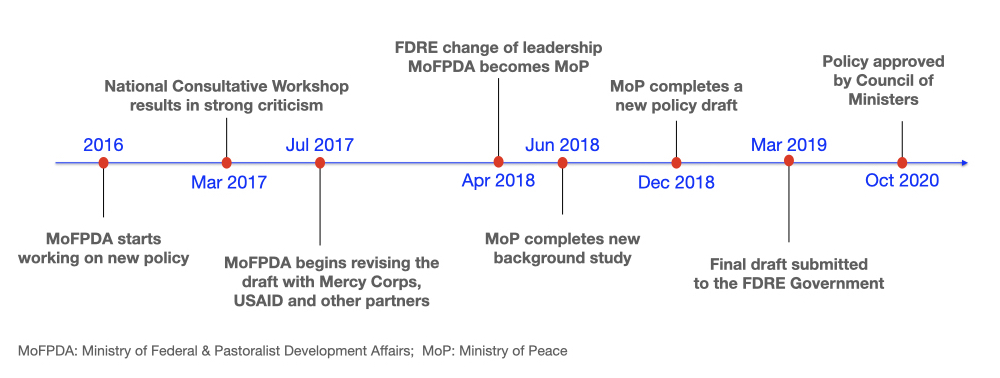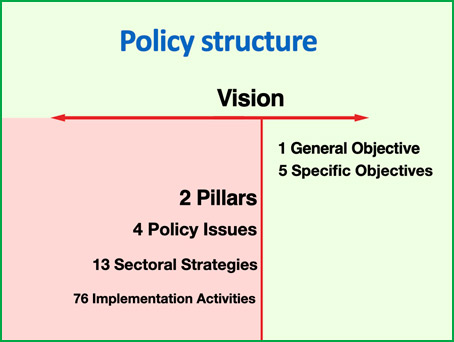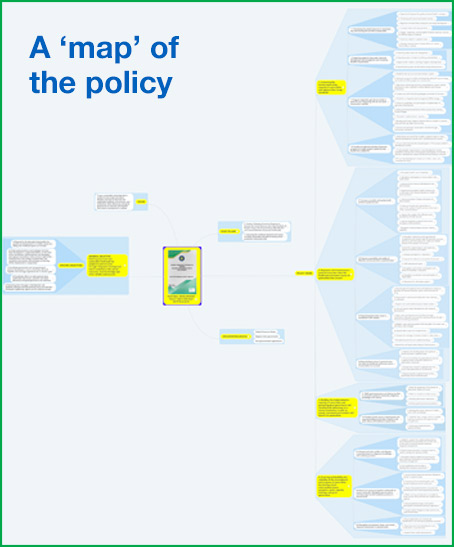NEP — Navigating Ethiopia’s Pastoral Development Policy
What do you think of Ethiopia's new pastoral policy?

TAKE A CLOSER LOOK AND TELL US WHAT YOU THINK
Approved by the Council of Ministers of the Federal Democratic Republic of Ethiopia in October 2020, the new Pastoral Development Policy and Strategy is meant as a framework for similar documents to be produced at the level of Ethiopia’s Regional States.
It is presented as a turning point in pastoral development. A move away from the mistakes of the past. But what does this policy really say? And how ‘new’ really is its orientation?
This space is dedicated to help civil society, researchers and planners navigating the policy. It provides a description of each element of the policy and an analytical commentary looking at the policy’s internal coherence. The analysis is based on the English text of the final draft presented to the Government of Ethiopia for approval in March 2019.

The following resources are available:
How to use the map
All the elements of the policy are represented in the map. Look for the little arrow on the right of each element. Clicking on the arrow takes to description and commentary.
Use the ‘post a comment’ option at the bottom of the pages to send us your feedback or additional information.
For those who prefer text to images, description and commentary are accessible also through the table of contents below.
This tool was developed by Saverio Krätli and Bart Vander Sanden with support from MISEREOR and CELEP.
TABLE OF CONTENTS
- A comparison with the African Union Policy Framework for Pastoralism
- FDRE Pastoral Development Policy and Strategy (2 comments)
- VISION: To see a pastoralist community that is resilient to man-made and natural disasters; that has an improved and sustainable livelihood, environment, and institutions; where democracy and good governance are ensured; and peaceful and inclusive development is realized (p.26)
- GENERAL OBJECTIVE: Realizing improved and sustainable livelihoods for people in pastoral areas through integrated development that is centred on the animal resources, local knowledge and other reliable endowments (p.26)
- Objective (a): Respond to the demands of pastoralists for growth and development in a holistic manner by taking their livelihood system as the basis (p.26)
- Objective (b): Guide sectoral policies and strategies that have been developed in a segmented fashion, on the basis of the constitution, national policies and strategies, and regional conventions, to be revised in light of the livelihood basis and ecology of pastoralists; and coordinate such policies and strategies so that they will be implemented in cooperation (p.26)
- Objective (c): Coordinate government and non-government pastoral development actors so that they will work together and exchange experiences for a common goal (p.26)
- Objective (d): Coordinate efforts to make pastoral areas sustainably food secure, peaceful; and where democracy and good governance are enshrined (p.26)
- Objective (e): Narrowing down the gaps in development and capability indicators between pastoral areas and relatively developed neighboring regions and the national average (p.26)
- BASIC PILLARS
- Pillar 1: Improving the livelihood standard and income of mobile pastoralists through increasing animal production and productivity; (maximizing and commercializing comparative and competitive advantages and potential) (p.27)
- Pillar 2: Conduct Voluntary Commune Programs to Improve the Income Sources and Living Standards of People Living in the Pastoral Areas (diversification and commercialization of pastoral livelihoods) (p.29)
- POLICY ISSUES / SECTORAL STRATEGIES / IMPLEMENTATION ACTIVITIES
- Policy Issue 1: Increasing the income-generating capacity of pastoralists and improve their living standards (p.31)
- 1.1 Developing the animal resources in maximized way and ensuring the benefits of pastoralists (p.33)
- a. Expand and improve the quality of animal health coverage (p.35)
- b. Protecting and improving livestock breeds (p.35)
- c. Expansion of animal feed production and range development (p.35)
- d. Increase market and input provision (p.36)
- e. Design, implement, and strengthen livestock extension services for different types of livestock (p.37)
- f. Improving research in pastoral areas (p.37)
- g. Develop livestock assets of pastoralists and reduce vulnerability to disaster (p.38)
- 1.2 Improving pastoral areas water resources development and management and increasing benefits of pastoralists (p.38)
- 1.3 Support adaptable agricultural activity in pastoral areas integrating with soil and water conservation methods (p.42)
- a. Establish land use and land administration system (p.44)
- b. Extension programs shall be developed by taking the agro-ecology and livelihood of the people into consideration (p.44)
- c. Agriculture technology provision and distribution system shall be developed in such a way that it will be effective and increase productivity (p.45)
- d. Create crop and horticulture packages convenient to the area (p.45)
- e. Establish an integrated pest management (IPM) strategy (p.45)
- f. Enhance coordination and participation of stakeholders of agriculture development (p.46)
- g. Make pastoralists beneficiaries of their products by creating market linkages (p.46)
- h. Strengthen implementation capacity (p.46)
- i. Develop small scale irrigation schemes that are suitable to pastoral areas and that use water economically (p.47)
- j. Conduct soil and water conservation activities through community mobilization (p.47)
- 1.4 Conduct pre-planned voluntary Commune programs to enable people in pastoral areas [to] benefit from settled life (p.48)
- a. Settle those who would like to settle in pastoral areas in newly selected development centers and in old development centers (p.49)
- b. Ensure maximized benefit and participation of the people settled in development centers (p.50)
- c. Create peoples’ organizations in new development centers; strengthen existing ones so that people’s participation and benefit sharing in development, peace and democracy building is ensured (p.50)
- d. Ensure that development centers are modern, clean, and convenient for living (p.51)
- 1.1 Developing the animal resources in maximized way and ensuring the benefits of pastoralists (p.33)
- Policy Issue 2: Expansion of infrastructure in pastoral areas that takes the livelihood and income source of pastoralists into account (p.51)
- 2.1 Increase accessible and quality health services in pastoral areas (p.51)
- a. Strengthen health sector leadership (p.53)
- b. Strengthen participation of communities in the health sector (p.53)
- c. Improve human resource development and administration (p.54)
- d. Expand and strengthen health infrastructure on the basis of the national standard on health service provision (p.54)
- e. Improve provision of inputs and system of administration (p.54)
- f. Create partnership with stakeholders to improve the quality of health services to the level of the national standard (p.55)
- g. Improve the quality of the efficiency and accessibility of health services (p.55)
- h. Improve capability to prevent and control emergency health problems (p.56)
- i. Strengthen evidence based decision making capability (p.56)
- 2.2 Improve accessibility and quality of education service provision in pastoral areas (p.56)
- a. Strengthen institutions and organizational arrangements that would make the education services effective at all levels taking the mobile and settled lifestyle of the people into account (p.57)
- b. Build the implementation and leadership capacity of teachers and leaders (p.58)
- c. Increase participation in education (p.58)
- d. Improve the relevance and quality of education (p.59)
- e. Fulfill educational inputs (p.59)
- f. Strengthen communities’ participation and sense of ownership in education (p.59)
- g. Strengthen coordination and participation of stakeholders (p.60)
- h. Modernize the information system (p.60)
- 2.3 Expand pastoral urban areas in coordination with industry (p.60)
- a. Develop plans for pastoral towns and settlement centers so that they will become beautiful, green, and convenient for living (p.61)
- b. Ensure land is used economically when town planning is undertaken (p.62)
- c. Expand micro and small enterprise market centers (p.62)
- d. Link and expand urban development with industrial development (p.62)
- e. Solve urban good governance problems through mobilization of people and avoid rent seeking attitude through institutional working procedures (p.63)
- f. Establish urban planning systems that strengthen the urban-rural and urban-urban linkages (p.63)
- g. Expand urban roads and transport lines (p.63)
- h. Increase the coverage of access to water in urban areas (p.64)
- i. Strengthening ditches and roadside buildings (p.64)
- j. Expand dry and liquid waste disposal infrastructures (p.64)
- 2.4 Expand infrastructure in pastoral areas that takes the livelihood and income source of pastoralists into account (p.65)
- a. Improve and develop power and quality of service provision in pastoral areas (p.66)
- b. Ensure accessibility of quality telecom services in pastoral areas so that the livelihood of pastoralists is improved (p.66)
- c. Expand road network in pastoral areas and ensure that pastoralists are beneficiaries (p.66)
- d. Expand airports in pastoral areas so that pastoralists would be beneficiaries (p.66)
- 2.1 Increase accessible and quality health services in pastoral areas (p.51)
- Policy Issue 3: Building the implementation capacity of pastoralists and grounding good governance and constitutional democracy on a strong foundation in order to ensure maximized participation and benefit for pastoralists (p.66)
- Policy Issue 4: Ensuring sustainability and reliability of the development and progress of pastoralists by treating critical cross-sectoral issues; economic, social, capacity building, and good governance (p.75)
- 4.1 Prevent and solve conflicts and disputes sustainably based on indigenous knowledge and customary practices (p.75)
- a. Establish a system that enables pastoralists to solve disagreements peacefully and on their own on the basis of pastoral woreda customary rangeland management; and by strengthening customary dispute settlement mechanisms and community peace organizational structures and procedures (p.77)
- b. Expand peace education in pastoral areas to create a society that deplores conflict; build a culture of peace; and encourage dispute settlement only through the constitutional framework and the law (p.77)
- c. Strengthen dispute related pre-warning and quick response mechanisms on the basis of the customary management; and create systems that enable dispute resolution before they are transformed into conflict (p.77)
- d. Link neighboring communities in development and good governance to enable creation of sustainable peace between them (p.77)
- 4.2 Ensure increasing participation and benefit of women and youth; strengthen good practices; and discourage harmful traditional practices in pastoral areas (p.77)
- a. Avoid harmful traditional practices inflicted on women in pastoral areas (p.78)
- b. Increasing all-round participation and benefit of pastoral women and youths (p.79)
- c. Ensure that pastoral women and youth are beneficiaries from income generating activities (p.79)
- d. Make training and education accessible for those women and youth who are outside school systems (p.79)
- e. Ensure pastoral women’s and youth’s participation and benefit sharing in agriculture (p.80)
- f. Create market linkages to make women and youth beneficiaries (p.80)
- 4.3 Strengthen environment, forest, and natural resources conservation in pastoral areas (p.80)
- 4.1 Prevent and solve conflicts and disputes sustainably based on indigenous knowledge and customary practices (p.75)
- Policy Issue 1: Increasing the income-generating capacity of pastoralists and improve their living standards (p.31)
- IMPLEMENTING BODIES (p.83) (2 comments)

